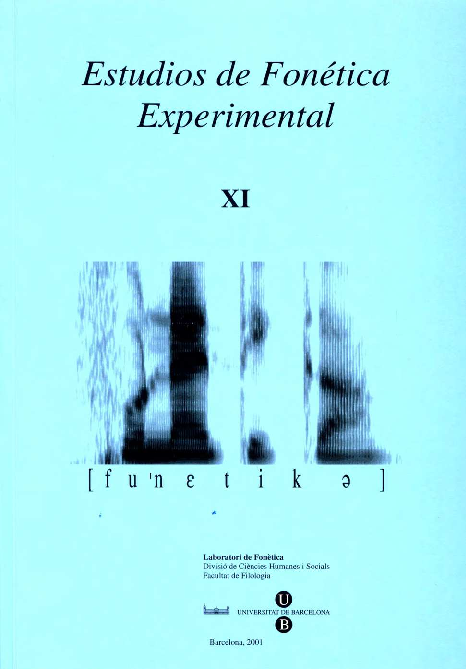Valores formánticos de la /e/ en sílaba abierta en la norma culta de Las Palmas de Gran Canaria
Abstract
This paper initiates the publication of the results obtained from a research project inserted in the frame of the Estudio de la norma lingüística culta del español de Las Palmas de Gran Canaria. It mainly focuses on the acoustic description of the sounds of Spanish as it is spoken in the Grand Canarian city. It is, thus, a first contribution aimed at expanding the contributions of the scant acoustic analyses made with materials of cultural linguistic norm in the Hispanic world.
For this occasion, we shall establish the frequential height of the two first formants of /e/ in open syllables. We shall attempt to prove whether there are linguistic or social factors that determine the variation of such average frequencies.
References
ALARCOS, E. (19654): Fonología española, Madrid, Gredos.
ALMEIDA, M. (1990): «El timbre vocálico en español actual», Revista de Filología Románica, 7, pp.75-85.
ÁLVAREZ GONZÁLEZ, J. (1981): «Influencias de los sonidos contiguos en el timbre de las vocales (estudio acústico)», Revista de la Sociedad Española de Lingüística,11,2, pp.427-445.
BERNALES, M. (1976): «Análisis espectrográfico comparado de las vocales de Valdivia y Chiloé», Estudios Filológicos,11, pp.59-70.
CÁRDENAS, D. N. (1960): «Acoustic vowel loops of two Spanish idiolects», Phonetica,5, pp.19-34.
CEPEDA, G; A. BARRIENTOS; A. BRAIN y J. C. MIRANDA (1991): «La alofonía de /e/ en el estrato alto de Valdivia: análisis sonográfico en sílaba abierta», Estudios Filológicos, 26, pp.83-98.
CEPEDA, G; A. BARRIENTOS y V. POBLETE (1995): «Análisis sonográfico frecuencial de las vocales del español de Valdivia (Chile)», Estudios Filológicos, 30, pp.81-96.
DELATTRE, P. (1948): «Un triangle acoustique des voyelles orales de français», The French Review, 21, pp.447-484.
DELATTRE, P. (1951): «The physiological interpretation of sound spectrograms», Publications of the Modern Language Association of America, 66, pp.864-876.
DELATTRE, P. (1965): Comparing the Phonetic Features of English, French, German and Spanish, Heidelberg, Chilton, Groos.
MARTÍNEZ CELDRÁN, E. (1984): Fonética, Barcelona, Teide.
MARTÍNEZ CELDRÁN, E. (1995): «En torno a las vocales del español: análisis y reconocimien¬to», Estudios de Fonética Experimental, 7, pp.197-218.
MARTÍNEZ CELDRÁN, E. (1996): El sonido en la comunicación humana, Barcelona, Octaedro.
NAVARRO TOMÁS, T. (1918): Manual de pronunciación española, Madrid, CSIC, 1972.
PÁEZ URDANETA, I. (1979): «Apertura y cerrazón vocálicas en español: evidencia idiodialec¬tal», Letras, 36, pp.129-157.
QUILIS, A. y M. ESGUEVA (1980): «Frecuencia de los fonemas en el español hablado», Lingüística Española Actual, 2, pp. 1-25.
QUILIS, A. y M. ESGUEVA (1983): «Realización de los fonemas vocálicos españoles en posición fonética normal», en M. Esgueva y M. Cantarero (eds.): Estudios de Fonética I, Madrid, CSIC, pp.159-252.
TRUJILLO, R. (1980): Lenguaje y cultura en Masca. Dos estudios, Santa Cruz de Tenerife, Editorial Interinsular Canaria, S. A. e Instituto Andrés Bello.
VAQUE¬RO, MªT. y L. GUERRA (1992): «Fonemas vocálicos de Puerto Rico (análisis acústico realizado con los materiales grabados para el estudio de la norma culta de San Juan)», RFE, 72, 3 4, pp.555 582.
Downloads
Published
How to Cite
Issue
Section
License

This work is licensed under a Creative Commons Attribution-NonCommercial-NoDerivatives 4.0 International License.
All articles published online by Estudios de Fonética Experimental are licensed under Creative Commons Attribution-NonCommercial-NoDerivs 4.0 International (CC BY-NC-ND 4.0 DEED), unless otherwise noted. Estudios de Fonética Experimental is an open access journal. Estudios de Fonética Experimental is hosted by RCUB (Revistes Científiques de la Universitat de Barcelona), powered by Open Journal Systems (OJS) software. The copyright is not transferred to the journal: authors hold the copyright and publishing rights without restrictions. The author is free to use and distribute pre and post-prints versions of his/her article. However, preprint versions are regarded as a work-in-progress version used as internal communication with the authors, and we prefer to share postprint versions.




